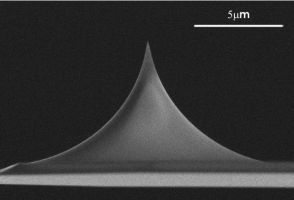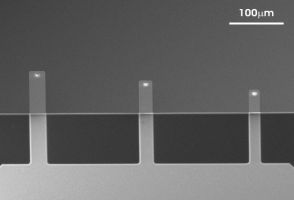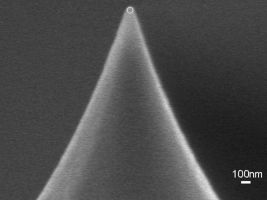Claire Leclech, Giulia Cardillo, Bettina Roellinger, Xingjian Zhang, Joni Frederick, Kamel Mamchaoui, Catherine Coirault and Abdul I. Barakat
Micro-Scale Topography Triggers Dynamic 3D Nuclear Deformations
Advanced Science, Online Version of Record before inclusion in an issue, 2410052
DOI: https://doi.org/10.1002/advs.202410052
Diede de Haan, Nahuel-Hernán Ramos, Yu-Feng Meng, Ron Rotkopf, Yoseph Addadi, Irit Rosenhek-Goldian and Assaf Gal
Decoupling cell size homeostasis in diatoms from the geometrical constraints of the silica cell wall
New Phytology, Volume 243, Issue 1, July 2024, Pages 258-270
DOI: https://doi.org/10.1111/nph.19743
Manli Guo, Dingcheng Guo, Lingzi Liao, Xiao Zhang, Zhilong Wang, Qiaozhen Zhou, Ping Chen, Ruiping Li, Bing Han, Guangjie Bao and Baoping Zhang
Ethanolic extract from Sophora moorcroftiana inhibit cell proliferation and alter the mechanical properties of human cervical cancer
BMC Complementary Therapies and Medicine, Volume 24, article number 212, (2024)
DOI: https://doi.org/10.1186/s12906-024-04502-5
Saori Sasaki, Keita Eguchi, Ming Wei, Ryu Takahashi, Toshihiro Sera, Naoki Takeishi and Susumu Kudo
Microscale unorganized wrinkle topographies on biomaterial surfaces modulate cell migration
Journal of Biorheology (2024) 38(2):120–125
DOI: https://doi.org/10.17106/jbr.38.120
Maaike Bril, Mirko D'Urso, Mario Prejanò, Matteo Costantini, Livia Angeloni and Nicholas A. Kurniawan
Digital Photoinduced Topographical Microsculpting of Hydrogels
Advanced Materials Technologies, Volume 9, Issue 23, December 2, 2024, 2400721
DOI: https://doi.org/10.1002/admt.202400721
Isabelle Martinier, Florian Fage, Alshaba Kakar, Alessia Castagnino, Emeline Saindoy, Joni Frederick, Ilaria Onorati, Valérie Besnard, Abdul I. Barakat, Nicolas Dard, Emmanuel Martinod, Carole Planes, Léa Trichet and Francisco M. Fernandes
Tunable biomimetic materials elaborated by ice templating and self-assembly of collagen for tubular tissue engineering
Biomaterials Science, 2024,12, 3124-3140
DOI: https://doi.org/10.1039/D3BM01808C
Alon Nudelman, Anjana Shenoy, Hyla Allouche-Arnon, Michal Fisler, Irit Rosenhek-Goldian, Lior Dayan, Paula Abou Karam, Ziv Porat, Inna Solomonov, Neta Regev-Rudzki, Amnon Bar-Shir and Irit Sagi
Proteolytic Vesicles Derived from Salmonella enterica Serovar Typhimurium-Infected Macrophages: Enhancing MMP-9-Mediated Invasion and EV Accumulation
Biomedicines 2024, 12(2), 434
DOI: https://doi.org/10.3390/biomedicines12020434
Reut Hazan (Ben‐Menachem), Dvora Lintzer, Tamar Ziv, Koyeli Das, Irit Rosenhek‐Goldian, Ziv Porat, Hila Ben Ami Pilo, Sharon Karniely, Ann Saada, Neta Regev‐Rudzki and Orphry Pines
Mitochondrial‐derived vesicles retain membrane potential and contain a functional ATP synthase
EMBO rep (2023) 24: e56114
DOI: https://doi.org/10.15252/embr.202256114
Claire Leclech, Apoorvaa Krishnamurthy, Laurent Muller, and Abdul I. Barakat
Distinct Contact Guidance Mechanisms in Single Endothelial Cells and in Monolayers
Advanced Materials Interfaces 2023, 10, 2202421
DOI: https://doi.org/10.1002/admi.202202421
Anita Akbarzadeh, Solbu, Andre Koernig, Joachim S. Kjesbu, Daria Zaytseva-Zotova, Marit Sletmoen, Berit L.Strand
High resolution imaging of soft alginate hydrogels by atomic force microscopy
Carbohydrate Polymers, Volume 276, 15 January 2022, 118804
DOI: https://doi.org/10.1016/j.carbpol.2021.118804
Javier Arturo Sanchez-Lopez, Shai Twena, Ido Apel, Shani Chen Kornhaeuser, Michael Chasnitsky, Andras G. Miklosi, Perla J. Vega-Dominguez, Alex Shephard, Amir Hefetz and Yael Heifetz
Male-female communication enhances release of extracellular vesicles leading to high fertility in Drosophila
Nature Communications Biology volume 5, Article number: 815 (2022)
DOI: https://doi.org/10.1038/s42003-022-03770-6
Paula Abou Karam, Irit Rosenhek-Goldian, Tamar Ziv, Hila Ben Ami Pilo, Ido Azuri, Anna Rivkin, Edo Kiper, Ron Rotkopf, Sidney R Cohen, Ana Claudia Torrecilhas, Ori Avinoam, Alicia Rojas, Mattia I Morandi and Neta Regev-Rudzki
Malaria parasites release vesicle subpopulations with signatures of different destinations
EMBO Reports (2022)23:e54755
DOI: https://doi.org/10.15252/embr.202254755
Masashi Yamazaki, Satoru Kidoaki, Hiromichi Fujie and Hiromi Miyoshi
Designing Elastic Modulus of Cell Culture Substrate to Regulate YAP and RUNX2 Localization for Controlling Differentiation of Human Mesenchymal Stem C
Analytical Sciences March 2021, VOL. 37, p. 447-453
DOI: https://doi.org/10.2116/analsci.20SCP02
https://www.jstage.jst.go.jp/article/analsci/37/3/37_20SCP02/_pdf
Ran Arieli
Endothelial Injury in Diving: Atomic Force-, Electronic-, and Light-Microscopy Study of the Ovine Decompressed Blood Vessels
Frontier in Physiology, 15 October 2021, Sec. Environmental, Aviation and Space Physiology
DOI: https://doi.org/10.3389/fphys.2021.767435
Sara Cavallaro, Federico Pevere, Fredrik Stridfeldt, André Görgens, Carolina Paba, Siddharth S. Sahu, Doste R. Mamand, Dhanu Gupta, Samir El Andaloussi, Jan Linnros and Apurba Dev
Multiparametric Profiling of Single Nanoscale Extracellular Vesicles by Combined Atomic Force and Fluorescence Microscopy: Correlation and Heterogeneity in Their Molecular and Biophysical Features
Nano Micro Small, Volume 17, Issue 14, April 8, 2021, 2008155
DOI: https://doi.org/10.1002/smll.202008155
Rishov Goswami, Rakesh K. Arya, Shweta Sharma, Bidisha Dutta, Dimitar R. Stamov, Xiaoping Zhuand and Shaik O. Rahaman
Mechanosensing by TRPV4 mediates stiffness-induced foreign body response and giant cell formation
Science Signaling, 2 Nov 2021, Vol 14, Issue 707
DOI: https://www.science.org/doi/10.1126/scisignal.abd4077
Anatolii A. Abalymov, Carlos A. B. Santos, Louis Van der Meeren, Davy Van de Walle, Koen Dewettinck, Bogdan V. Parakhonskiy and Andre G. Skirtach
Nanofibrillar Hydrogels by Temperature Driven Self-Assembly: New Structures for Cell Growth and Their Biological and Medical Implications
Advanced Materials & Interfaces, Volume 8, Issue 15, August 9, 2021, 2002202
DOI: https://doi.org/10.1002/admi.202002202
Anatolii Abalymov, Louis Van der Meeren, Dmitry Volodkin, Bogdan Parakhonskiy, and Andre G. Skirtach
Carbon Nanotubes Transform Soft Gellan Gum Hydrogels into Hybrid Organic–Inorganic Coatings with Excellent Cell Growth Capability
Journal of Carbon Research, C 2021, 7(1), 18;
DOI: https://doi.org/10.3390/c7010018
Adelaide Miranda, Ana I. Gómez-Varela, Andreas Stylianou, Liisa M. Hirvonen, Humberto Sánchez and Pieter A. A. De Beule
How did correlative atomic force microscopy and super-resolution microscopy evolve in the quest for unravelling enigmas in biology?
(Review Article) Nanoscale, 2021, 13, 2082-2099
DOI: 10.1039/D0NR07203F
https://pubs.rsc.org/en/content/articlehtml/2020/nr/d0nr07203f
Ana I. Gómez-Varela, Dimitar R. Stamov, Adelaide Miranda, Rosana Alves, Cláudia Barata-Antunes, Daphné Dambournet, David G. Drubin, Sandra Paiva and Pieter A. A. De Beule
Simultaneous co-localized super-resolution fluorescence microscopy and atomic force microscopy: combined SIM and AFM platform for the life sciences
Nature Scientific Reports volume 10, Article number: 1122 (2020)
DOI: https://doi.org/10.1038/s41598-020-57885-z
Boris Buchroithner, Delara Hartmann, Sandra Mayr, Yoo Jin Oh, Dmitry Sivun, Andreas Karner, Bianca Buchegger, Thomas Griesser, Peter Hinterdorfer, Thomas A. Klar and Jaroslaw Jacak
3D multiphoton lithography using biocompatible polymers with specific mechanical properties
(Paper) Nanoscale Adv., 2020, 2, 2422-2428
DOI: 10.1039/D0NA00154F
https://pubs.rsc.org/ko/content/articlehtml/2020/na/d0na00154f
Catarina Costa Moura, Adelaide Miranda, Richard O.C.Oreffo, Pieter A.A.De Beule
Correlative fluorescence and atomic force microscopy to advance the bio-physical characterisation of co-culture of living cells
Biochemical and Biophysical Research Communications, Volume 529, Issue 2, 20 August 2020, Pages 392-397
DOI: https://doi.org/10.1016/j.bbrc.2020.06.037
Hiroyuki Ebata, Kousuke Moriyama, Thasaneeya Kuboki, Satoru Kidoaki
General cellular durotaxis induced with cell-scale heterogeneity of matrix-elasticity
Biomaterials, Volume 230, February 2020, 119647
DOI: https://doi.org/10.1016/j.biomaterials.2019.119647
Anatolii Abalymov, Louis Van der Meeren, Andre G. Skirtach, and Bogdan V. Parakhonskiy
Identification and Analysis of Key Parameters for the Ossification on Particle Functionalized Composites Hydrogel Materials
ACS Appl. Mater. Interfaces 2020, 12, 35, 38862–38872
DOI: https://doi.org/10.1021/acsami.0c06641
Anatolii A. Abalymov, Louis Van der Meeren, Davy Van de Walle, Koen Dewettinck, Andre G. Skirtach, Bogdan V. Parakhonskiy
Meshes‐to‐Fibrils Transition of Gellan Gum Hydrogel Architecture by Thermal Annealing
Macromolecular Materials and Engineering, early view online Version of Record before inclusion in an issue
DOI: https://doi.org/10.1002/mame.202000308
Hiroyuki Ebata, Satoru Kidoaki
Avoiding tensional equilibrium in cells migrating on a matrix with cell-scale stiffness-heterogeneity
bioRxiv preprint
DOI: https://doi.org/10.1101/2020.10.15.342006
https://www.biorxiv.org/content/biorxiv/early/2020/10/16/2020.10.15.342006.full.pdf
Anatolii Abalymov, Louis Van der Meeren, Mariia Saveleva, Ekaterina Prikhozhdenko, Koen Dewettinck, Bogdan Parakhonskiy, and Andre G. Skirtach
Cells-Grab-on Particles: A Novel Approach to Control Cell Focal Adhesion on Hybrid Thermally Annealed Hydrogels
ACS Biomater. Sci. Eng. 2020, 6, 7, 3933–3944
DOI: https://doi.org/10.1021/acsbiomaterials.0c00119
https://pubs.acs.org/doi/abs/10.1021/acsbiomaterials.0c00119
Kei Sugihara, Saori Sasaki, Akiyoshi Uemura, Satoru Kidoaki and Takashi Miura
Mechanisms of endothelial cell coverage by pericytes: computational modelling of cell wrapping and in vitro experiments
Journal of the Royal Society
DOI: https://doi.org/10.1098/rsif.2019.0739
https://royalsocietypublishing.org/doi/full/10.1098/rsif.2019.0739
Christian Titus Kreisa and Ruby May A. Sullan
Interfacial nanomechanical heterogeneity of the E. coli biofilm matrix
Nanoscale, 2020,12, 16819-16830
DOI: https://doi.org/10.1039/D0NR03646C
S Sasaki, S Kidoaki
Precise design of microwrinkles through the independent regulation of elasticity on the surface and in the bulk of soft hydrogels
Polymer Journal volume 52, pages515–522(2020)
DOI: https://doi.org/10.1038/s41428-019-0299-8







 Due to their unique geometry the tips of the uniqprobes are more susceptible to tip damage by electrostatic discharge (ESD) than other Silicon-SPM-Probes.
Due to their unique geometry the tips of the uniqprobes are more susceptible to tip damage by electrostatic discharge (ESD) than other Silicon-SPM-Probes.


